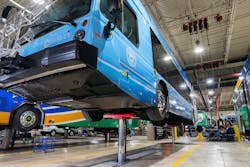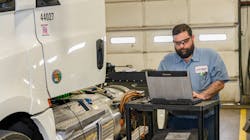When Milwaukee County Transit System’s maintenance garage got a push from county officials to start electrifying their fleet, management knew it was time for some equipment upgrades to their shop.
Management’s first concern was dealing with the significant weight capacity increase their lifts would need going from 13-ton diesel buses to 18-ton electric ones.
MCTS’ Ron McCorkel, director of maintenance, and Dwyane Reese, deputy director of maintenance, went right to pricing new lifts that could hold the extra weight. And thanks to their budget strategy for capital improvements calculated every five years, they were able to purchase 14 Stertil-Koni in-ground telescopic piston DIAMONDLIFTs and 16 Mobile Column Lifts.
“We had to make sure that we invested in some equipment that would take us into the next 15-20 years and plan just in case the next group of buses gets heavier,” McCorkel said.
No matter the size, all fleet maintenance operations must accurately estimate their budgets to keep up with changes in equipment and technology, as well as offer competitive wages to increasingly in-demand labor.
Tracking the known
Transervice uses a home-grown system that tracks the number and age of their assets, predictable and demand maintenance needs, and labor costs to calculate their budgets. One critical metric they track is wearable component replacement.
“We can look at brake pads and know what those parts cost today and calculate how often we will need to replace them over the life of the vehicle,” said Michael Dominguez, VP of business operations at Transervice. “We do an analysis based on the number of miles the vehicle will operate each year, factoring for both normal wear and tear and severe conditions, the expected life span for the vehicle, and where it will be operated. We couple that with our manpower formulas for labor cost.”
Focusing on part life also helps a shop reduce the incidents of emergency repairs, which lead to higher unexpected costs. That predictability helps manage a budget more effectively, according to Robert Ziemba, marketing lead at Decisiv, a provider of service relationship management solutions.
The company recently developed calculators to help predict revenue increases. Decisiv also focuses on optimizing repair events, which helps fleets avoid taking trucks back out of service and taking a hit on the revenue side. This helps both the cost management and revenue generation side of the budget, said Mark Wasilko, VP of marketing at Decisiv.
“A Decisiv calculator won’t help budget, but it will remind you of the reason to do it,” Wasilko said. “If you’re on a platform and you’re proactive, then you’re optimizing the service scheduling and the work that you’ve done and more intelligently budgeting repairs.”
See also: Coordinating and optimizing preventive maintenance
Sometimes the best predictor of the future is to look at the past. Truckway Leasing, a full-service commercial leasing, rental, and maintenance provider, bases its maintenance budget on a percentage of revenue derived from historical costs.
Eric Silz, Truckway’s maintenance manager, said that’s easier said than done. Those historical costs have to contend with the low mileage rates they are forced to charge, skyrocketing dealer labor rates, and increased parts and tire costs. But in the rental and leasing world, the more units on the road, the more the revenue will increase.
A poorly planned budget has a direct effect on a shop’s bottom line, ultimately impacting the employees, Silz said.
Current challenges in budgeting
Planning for new equipment
While Americans continue to pivot their spending for inflation, forecasting equipment sales specifically in today’s equipment market remains challenging, Transervice’s Dominguez explained.
Silz agreed, adding that even the newest tech software and the smartest accountants in the industry could not have budgeted for the unpredictable costs incurred in recent years, including the additional diagnostic laptops and software needed to troubleshoot the many different types of vehicles at each Truckway facility.
“A typical trucking company may run a fleet of 100 vehicles, all the same make and model trucks,” Silz said. “In the leasing and contract maintenance business, we find ourselves working on many different makes and models and having to be that chameleon when it comes to the equipment in our shops.”
Silz said Truckway has increased its annual budget for laptops and OEM software in the past few years.
All fleets will have to consider these extra expenses, as the diagnostic tool-to-technician ratio will go from 4:1 to 2:1 in the next three years, according to Noregon, a provider of commercial vehicle diagnostic & repair software and data analytics solutions.
Transervice’s budget challenges include equipment price changes, the lack of detailed information on electric vehicles and autonomous trucks, and AI coming into the industry, Dominguez said. Labor wages must be evaluated annually to remain competitive in the industry, he added.
Truckway has had to set aside some of its plans for new equipment, specifically trucks, and make do with what they already have, Silz said. Truck allocations and shortages in production are forcing fleets to operate their assets longer. In turn, running trucks past their prime drives up maintenance expenses.
On the other hand, Chuck Drews, product manager at Fleetio, a web-based fleet management software, encourages fleet managers to avoid making macroeconomics or global supply chain issues their primary focus, but instead use digital management technology to track and report data that is specific to their fleet.
“The biggest challenge for organizations is that they have no solution to enable decision-making,” Drews said. “Maybe they’re tracking on the spreadsheet, maybe they’re on paper. They just have nothing to go into to extract that and make decisions with. The role and responsibility of fleet managers is not to be an analyst. So, it’s just challenging for them to take their qualitative feedback about resourcing or budget constraints and then translate that to their leadership without data to support what they’re saying.”
Longer downtime due to parts shortages
Truckway provides “Up-Time” service to their customers. This means that when their customers’ truck goes down, Truckway will provide each customer with a replacement unit at no charge to them. The company does budget for “Up-Time” expenses, however, over the past several years, it has experienced an increase in downtime of their units due to parts shortages from the OEMs and labor shortages at the dealerships.
“We have had some instances where a truck was down for four months waiting on back-ordered parts,” Silz said. “If a rental truck is being used for a replacement unit, this becomes lost revenue on the rental side of our business. This increased downtime has created a new challenge for our industry in the past two years.”
Staying competitive during labor shortages
The challenges of finding talented labor and retaining techs have forced Truckway to increase wages by 16% in the last two years. That’s up from a 3% annual wage increase in years past.
“Our biggest concern is finding talented labor,” Silz said. “We spend a ton of money and energy recruiting new technicians while at the same time doing our best to ensure we keep our current technicians happy.”
Another challenge Truckway faces is not only finding good technicians but also finding good technicians that will work late shifts and weekends, catering to the needs of their customers who are on the roads 24/7.
“One of the things we have done to make the late shifts more appealing is to implement a larger per-hour shift differential,” Silz explained. “This can be as much as a 20% increase in pay, based on their base wage.”
See also: In the midst of change, trucking needs to foster excitement
Budgeting for EVs
For fleets looking to electrify, Fleetio’s Drews encourages owners and managers to be realistic about how feasible that transition is for their business and consider their appetite for investment.
“Fleet managers should consider what level of charging infrastructure they have in their in-house facilities today,” Drews said. “Is your organization prepared for the capital investment required to install all of these pieces of machinery and the ongoing uptick in the cost of electricity to support these?”
He also encourages fleet operators to get out and speak to other fleets in the process of electrification so they can understand the challenges they face, including a lack of charging locations and the associated downtime.
“It might be that there are lots of chargers close by, but they found that most of them aren’t operating correctly,” Drews said. “You would have to wait two hours just to be able to access the ones that are left over. Seeing how it works in the real world, that’s a priceless base.”
Silz believes the transition to electrification for his fleet won’t happen anytime soon.
“Until the costs of electric vehicles come down, mileage ranges can be extended, and the infrastructure is put in place, this is a non-event for most of our customers at this time,” Silz said. “I do believe the industry will eventually get this right, but only a few applications make sense right now. Yard spotters make a ton of sense to be electrified, as those vehicles can sit and charge all night and aren’t expected to haul heavy loads over long distances. Also, local delivery truck fleets, buses, and postal service all haul lighter loads and have predictable downtime.”
MCTS’ McCorkel said that while fleets are dealing with the messy middle and multiple powertrains, it’s best to stick to a single engine and a single transmission. This makes budgeting for training, tooling, and equipment easier for now.
“That narrows down what my staff has to be exposed to and not having a lot of different parts on their shelves,” he said. “Our 344 buses are all Allison transmissions and all Cummins engines. That simplifies it.”
About the Author
Cris Beaulieu
Cris Beaulieu is an Associate Editor for Fleet Maintenance magazine. She joined the team after working in local news media. She earned a bachelor’s in journalism at Cleveland State University along with a TV and Radio Broadcast degree at Ohio Media School.



